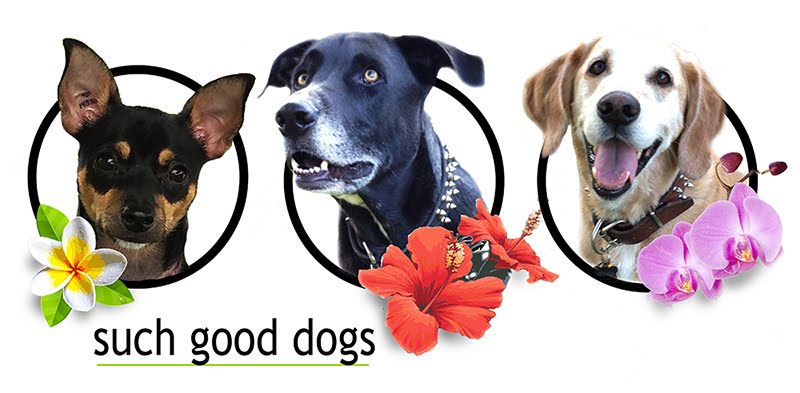Learning the "Watch Me" or "Look" Cue...
For teaching many new cues it is helpful to use a
food lure. Remember to use high value food rewards when training using food lures. A
food lure involves getting the dog to follow your hand into a desired position. This is how we first teach many behaviors such as Sit and Down.
Using a food lure for the
"Watch Me" cue is very effective. This exercise is what you will do if your dog becomes distracted in class and unable to focus. Place the stinky dog treat directly in front of the dogs nose, then up to your forehead. As soon as the dog looks up at you, say your marker word (Good or Yes) and give the dog the treat. After you have done this a few times and the dog is starting to quickly look up at you (preferably at your eyes), then you can add the verbal cue of "Watch Me" or "Look."
Stinky treat in the dog's nose, then up to your forehead. Dog looks, "Good!" and treat.
Teaching a dog the "Watch Me" cue is an excellent way to help build a good bond between you and your dog. You want a dog that pays attention to you and looks to you for guidance.
Food luring a young puppy into a sit is an easy and effective way to teach this behavior. In class I will demonstrate this technique.
When teaching new behaviors and cues it is often helpful to have both a Verbal Cue and a Hand Signal. These basic hand signals will also be demonstrated in class.
Come when called:
The Rules:
1. Always have a leash.
2. When you say come, you have to see the dog come to you.
3. NEVER punish a dog for coming to you.
The Steps:
1. Say the dog's name, and Come, one time only.
2. Have a party.
3. Lure the dog back to you.
When teaching a dog the Come Cue for the first time we start with Step 3, luring the dog. Put the treat in the dog's nose, say "Name, Come!," quickly back up a few steps. When the dog follows stop, say "Good," and treat. (Explained and demonstrated in class).
Loose-Leash Walking:
Helpful tools for teaching a dog to properly walk on a leash: gentle leaders, easy-walk harness.
Loose Leash Walking (LLW) means the dog walks nicely, not pulling on the leash.
(Also see
previous post.)
Now, loose leash walking is not the same thing as heel. LLW means the dog is walking nicely on the leash, but in no specific place. Heel is when a dog walks next to you, directly at your side. Heel is a step up from LLW. Teaching a dog heel is like going to college, but before we can go to higher education, we must first start in Kindergarden with Loose Leash Walking.
Teaching a dog to proper walk on a leash is actually quite easy, but requires a LOT of patience! Patience is the most important tool you can bring when teaching this to your dog.
Its quite simple really. To begin, go out for a walk using a regular 4-6 foot leash (NEVER use an extenda-leash), and a buckle color properly fitted to your dog's neck (so they cannot slip out). As you begin your walk, as soon as your dog pulls, stop directly in your tracks. Do not pull on the leash, just freeze yourself and wait for your dog to release the tension on the leash. Once s/he does, mark that behavior with a "good girl," or "good boy," and continue on your walk. When the dog pulls again, stop, wait, the dog releases the tension, "good dog." Like I said, very simple but requires an immense amount of patience!!!
(Demonstrated in class).
Homework for week 3:
Come when called
Watch me
Loose leash walking












